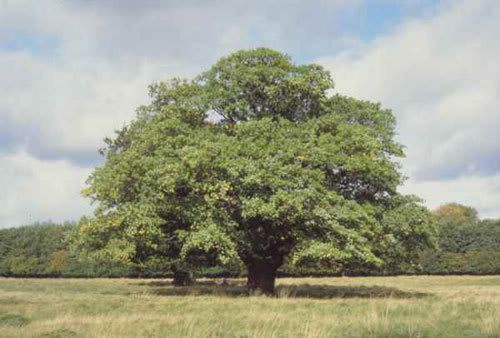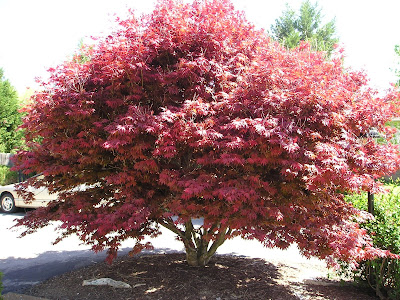The Larch

Larches are conifers in the genus Larix, in the family Pinaceae. They are native to much of the cooler temperate northern hemisphere, on lowlands in the far north, and high on mountains further south. Larches are among the dominant plants in the immense boreal forests of Russia and Canada.
They are deciduous trees, growing from 15-50 m tall. The shoots are dimorphic, with growth divided into long shoots typically 10-50 cm long and bearing several buds, and short shoots only 1-2 mm long with only a single bud. The leaves are needle-like, 2-5 cm long, slender (under 1 mm wide). They are borne singly, spirally arranged on the long shoots, and in dense clusters of 20-50 needles on the short shoots. The needles turn yellow and fall in the late autumn, leaving the trees leafless through the winter.
Larch cones are erect, small, 1-9 cm long, green or purple, ripening brown 5-8 months after pollination; in about half the species the bract scales are long and visible, and in the others, short and hidden between the seed scales. Those native to northern regions have small cones (1-3 cm) with short bracts, with more southerly species tending to have longer cones (3-9 cm), often with exserted bracts, with the longest cones and bracts produced by the southernmost species, in the Himalaya.
Species and classification
There are 10-14 species; those marked with an asterisk (*) in the list below are not accepted as distinct species by all authorities.[citation needed] In the past, the cone bract length was often used to divide the larches into two sections (sect. Larix with short bracts, and sect. Multiserialis with long bracts), but genetic evidence (Gernandt & Liston 1999) does not support this division, pointing instead to a genetic divide between Old World and New World species, with the cone and bract size being merely adaptations to climatic conditions. More recent genetic studies have proposed three groups within the genus, with a primary division into North American and Eurasian species, and a secondary division of the Eurasian into northern short-bracted species and southern long-bracted species (Semerikov & Lascoux 1999; Wei and Wang 2003, 2004; Gros-Louis et al. 2005); there is some dispute over the position of Larix sibirica, a short-bracted species which is placed in the short-bracted group by some of the studies and the long-bracted group by others.
Eurasian
Northern, short-bracted
* Larix decidua (syn. L. europaea) European Larch. Mountains of central Europe.
* Larix sibirica Siberian Larch. Plains of western Siberia.
* Larix gmelinii (syn. L. dahurica) Dahurian Larch. Plains of central Siberia.
* Larix cajanderi (syn. L. dahurica) Dahurian Larch. Plains of eastern Siberia.
* Larix kaempferi (syn. L. leptolepis) Japanese Larch. Mountains of central Japan.
* Larix principis-rupprechtii Prince Rupprecht's Larch *. Mountains of northern China (Shanxi, Hebei).
o Olgan Larch or Olga Bay Larch (Larix gmelinii var. olgensis) is sometimes treated as a distinct species Larix olgensis.[1]
Southern, long-bracted
* Larix potaninii Chinese Larch. Mountains of southwestern China (Sichuan, northern Yunnan).
* Larix himalaica Langtang Larch *. Mountains of central Himalaya.
* Larix mastersiana Masters' Larch. Mountains of western China.
* Larix speciosa Yunnan Larch *. Mountains of southwest China (southwest Yunnan), northeast Myanmar.
* Larix griffithii (syn. L. griffithiana) Himalayan Larch. Mountains of eastern Himalaya
North American
* Larix laricina Tamarack Larch or American Larch. Plains of northern North America.
* Larix lyallii Subalpine Larch. Mountains of northwest USA and southwest Canada, at very high altitude.
* Larix occidentalis Western Larch. Mountains of northwest USA and southwest Canada, at lower altitudes.
Most if not all of the species can be hybridised in cultivation. The best known hybrid is the Dunkeld Larch Larix × marschlinsii (syn. L. × eurolepis, an illegitimate name), which arose more or less simultaneously in Switzerland and Scotland when L. decidua and L. kaempferi hybridised when planted together.
Larch is used as a food plant by the larvae of a number of Lepidoptera species - see list of Lepidoptera that feed on larches.
Larches are prone to the fungal canker disease Lachnellula willkommii (Larch Canker); this is particularly a problem on sites prone to late spring frosts, which cause minor injuries to the tree allowing entry to the fungal spores.
Uses
Larch is a wood valued in for its tough, waterproof and durable qualities; top quality knot-free timber is in great demand for building yachts and other small boats, for exterior cladding of buildings and interior panelling. The timber is resistant to rot when in contact with the ground, and is suitable for use as posts and in fencing. The hybrid Dunkeld Larch is widely grown as a timber crop in northern Europe, valued for its fast growth and disease resistance.
Larch has also been used in herbal medicine; see Bach flower remedies for details.
In central Europe larch is viewed as one of the best wood materials for the building of residences. Planted on borders with birch, both tree species were used in pagan "sagged" cremations. One "sąg" (pronounced song) of wood was required for a cremation stack. Sąg is used today as a Polish forestry unit measuring approximately 3 × 1 × 1 m.
In Siberia young larch leaves are harvested in spring, preserved by lactobacillus fermentation, and used for salads during winter.
Larches are often used in bonsai culture, where their knobby bark, small needles, fresh spring foliage and especially autumn colour are appreciated. European Larch, Japanese Larch and Tamarack Larch are the species most commonly trained as bonsai.
Popular culture
The Larch is a running joke in several Monty Python sketches beginning with the first season episode "How to Recognise Different Types of Trees From Quite a Long Way Away". (And now for something completely different. Number one, the larch. Number two, the larch...)






